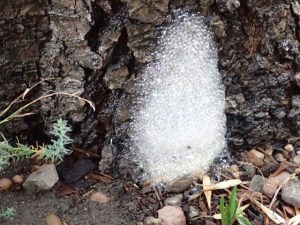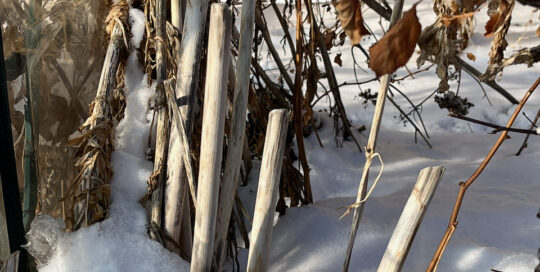Slime flux looks like spittlebugs on steroids
Views: 7850

A few weeks ago a friend touched base to see what might be creating an astounding amount of frothy slime flux on her trees. Our first thought was spittlebugs. It looked exactly like the bubbly mixture formed when the juices of the part of the plant the immature spittlebugs are eating mix with a special substance from their bodies. This creates the foam that keeps the immature nymphs moist, as well as protects them from predators, although many birds know all they need to do is to put their beak through the foam to find their meal.
If the foam was in the spring or early summer, we probably would have stayed with the spittlebug theory, but this was during the harvest, it was on the trunk instead of the branches, and there was just too much of it. At one point, the foam was streaking down the trunk. After researching the options, it appears the pear tree had a case of slime flux, also called wetwood because of the appearance it creates on the bark.
Characteristics
As the name implies, the primary symptom of slime flux is the nasty, foamy substance formed on the trunk. This is due to a bacterial infection (and it can be a number of different types of bacteria) within the trunk of the tree. As the infection progresses, the carbon dioxide created through the fermentation process within the tree breaks through a spot in the trunk, and the slime oozes out. Many times it has a strong, alcohol-like smell (due to the fermentation), and can attract insects to the tasty mess.
What will it do?
The good news is the slime really doesn’t harm the tree unless there is a lot of it, or it’s happening on an already weakened specimen. That’s the only part that puzzles me because this is the largest, most beautiful pear tree I’ve ever seen in Great Falls. It’s massive… truthfully, I didn’t think pear trees could grow that large around here. Plus, it was very fruitful this year. Although we had a dry summer, I know it received water and care. I guess slime flux is just one of those things that can happen even on a healthy tree.
Thankfully, the slime flux doesn’t seem to bring in pests that spread disease to the tree, which is good news since most would think this is a prime situation for them. And fortunately it came off the tree easily with a steady rain.
If you find slime flux on your trees, and it can happen to most deciduous trees, don’t panic. Simply wash it off if it bothers you, and be sure you keep your tree as healthy as possible to give it a chance to successfully battle these types of infections on its own.
Meet Amy Grisak
Amy is a freelance author and photographer in Great Falls, MT who specializes in gardening, foods, and sustainable agriculture. She provides information on every kind…
Amy's Recent Posts

This Little Piggy is a Problem: Dealing with Feral Hogs








